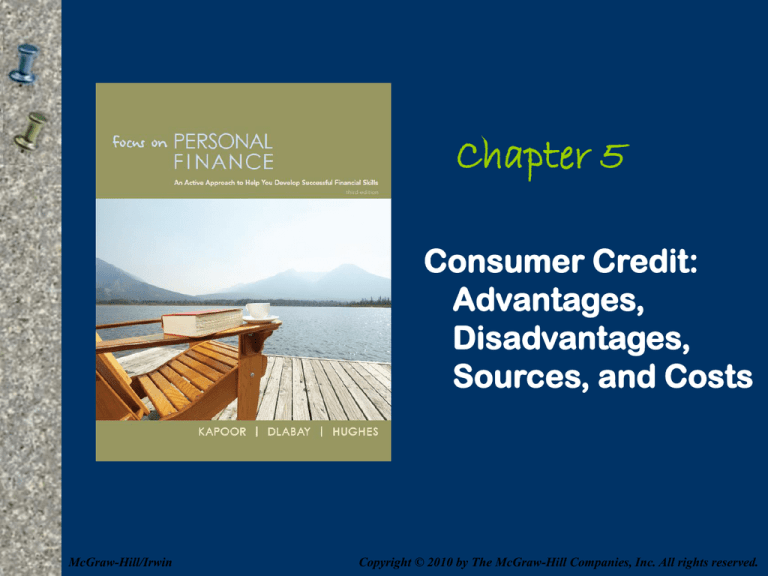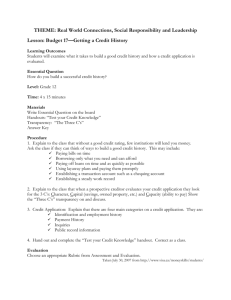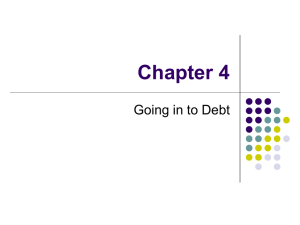
Chapter 5
Consumer Credit:
Advantages,
Disadvantages,
Sources, and Costs
McGraw-Hill/Irwin
Copyright © 2010 by The McGraw-Hill Companies, Inc. All rights reserved.
Consumer Credit
Chapter Objectives
1. Analyze advantages and disadvantages of
using consumer credit
2. Assess the types and sources of consumer
credit
3. Determine whether you can afford a loan
and how to apply for credit
4. Determine the cost of credit by calculating
interest using various interest formulas
5. Develop a plan to protect your credit and
manage your debts
5-2
Objective 1
Analyze Advantages and Disadvantages
of Using Consumer Credit
• Credit
– An arrangement to receive cash, goods or
services now, and pay for them in the future
– Based on trust in people’s ability and
willingness to pay bills when due
• Consumer credit
– Use of credit by individuals for personal
needs, except a home mortgage
– A major force in our economy
5-3
Uses and Misuses of Credit
• Before you use credit for a major purchase,
consider:
–
–
–
–
–
–
Do I have the cash for the down payment?
Do I want to use my savings for this purchase?
Does the purchase fit my budget?
Could I use the credit I’ll need in some better way?
Can I postpone this purchase?
What are the opportunity costs of postponing this
purchase?
– What are the dollar and psychological costs of
using credit for this purchase?
5-4
Advantages of Credit
• Current use of goods and services
• Permits purchase even when funds are
low
• A cushion for financial emergencies
• Advance notice of sales
• Easier to return merchandise
• Convenient when shopping
• Provides a record of expenses
5-5
Advantages of Credit
• One monthly payment
• Safer than carrying cash
• Needed for hotel reservations, car
rentals, and shopping online
• Take advantage of float time/grace
period
• Rebates, airline miles, or other
bonuses
• Credit indicates financial stability
5-6
Disadvantages of Consumer Credit
• Temptation to overspend
• Can create long-term financial
problems and slow progress
toward financial goals
• Potential loss of merchandise
due to late or non-payment
• Ties up future income
• Credit costs money - more costly
than paying with cash
5-7
Objective 2
Assess the Types & Sources of
Consumer Credit
Two Basic Types of Consumer Credit
•
Closed-End Credit
– One-time loans for a specific purpose paid
back in a specified period of time
• Open-End Credit
– Use as needed until line of credit max
reached
5-8
Closed-End Credit
• One-time loans for a specific purpose that
you pay back in a specified period of time,
and in payments of equal amounts
• Mortgage, automobile, and installment loans
for furniture, appliances and electronics
• 3 most common types of closed-end credit
1.Installment sales credit
2.Installment cash credit
3.Single-lump credit
5-9
Open-End Credit
• Use as needed until line of credit max reached
– Credit cards
– Department store cards
– Home equity loans
• You pay interest and finance charges if you do
not pay the bill in full when due
• Revolving check credit
• Bank line of credit
5-10
Sources of Consumer Credit
Loans
– Borrowing money with an agreement to repay
along with interest within a certain amount of
time
• Inexpensive loans
– Parents or family members
• Medium-priced loans
– Commercial banks, savings and loan
associations, and credit unions
• Expensive loans
– Finance and check cashing companies
– Retailers such as car or appliance dealers
– Bank credit cards and cash advances
5-11
Sources of Consumer Credit
• Home Equity Loans
– Loan based on your home equity
• Current market value of your home minus the
amount you still owe on the mortgage
– Interest is tax deductible
– Should only be used for major purchases
• Credit Cards
– Average cardholder has > 9 credit cards
– Convenience users vs. Borrowers
– Finance charge = total amount paid to use
credit
5-12
Sources of Consumer Credit
• Debit Cards
– Debit cards electronically
subtract money from your
savings or checking accounts
– Most commonly used at ATMs
• Stored Value Cards
– Gift cards
– Prepaid cards
5-13
Sources of Consumer Credit
• Smart Cards
– Plastic card equipped with a
computer chip that can store
500 times as much data as
a normal credit card
• Travel and Entertainment (T&E) cards
– Not really “credit cards”; balance is due in
full each month
– Diners Club; American Express
– You don’t pay for services or goods at the
time you purchase them
5-14
Objective 3
Determine Whether You Can Afford a
Loan and How to Apply for Credit
Before you take out a loan, ask
yourself...
Can you meet all your essential
expenses and still afford the
monthly loan payments ?
– What do you plan to give up in order to
make the payment?
5-15
General Rules of Credit Capacity
Debt Payments-to-Income Ratio
Monthly Debt Payments*
Net Monthly Income
Consumer credit payments should not
exceed a maximum of 20% of your net
income.
*Not including house payment which is a long-term liability
5-16
General Rules of Credit Capacity
Debt To Equity Ratio
Total Liabilities
= Should be < 1
Net Worth*
*Excluding home value
5-17
The Five C’s of Credit
• Character - Do you pay bills on time?
• Capacity - Can you repay the loan?
• Capital - What are your assets
and net worth?
• Collateral - What assets do you have to
secure the loan?
• Conditions- Lenders will review how general
economic conditions will affect your ability
to repay your loan
5-18
FICO & VantageScore
• FICO Credit Score
– 350 to 850
– Higher score = less risk
– Available from http://www.myfico.com for a
fee
• VantageScore
– New scoring technique
– Developed collaboratively by 3 credit
agencies
– Range = 501 to 990
5-19
Factors of Creditworthiness
• ECOA (Equal Credit Opportunity Act)
– Gives all applicants the same rights.
– Credit providers may not discriminate based on:
• Age
• Social Security or public assistance
• Housing loans (redlining)
– If you are denied credit, you have the right
to know the reasons
• You can request a copy of your credit report
within 60 days if you are denied credit
based on what is in your files
5-20
Your Credit Report
• Credit Reports
– Record of your complete credit history
• Credit Bureaus
– Agencies that collect information on how
promptly people and businesses pay their
bills
– Experian, Trans Union and Equifax are
the 3 major credit bureaus
– Credit Bureaus obtain information from
banks, finance companies stores, credit
card companies and other lenders
5-21
Your Credit Report
• Credit Files
– Typically contain detailed credit data
along with considerable personal
information:
• Name, address, SSN, DOB (self & spouse)
• Employer, position and income (current &
previous, self and spouse)
• Home owner or renter
• Fair Credit Reporting Act (1971)
– Law allows out-of-date information to be
deleted, as well as the right to correct
misinformation
5-22
Your Credit Report
• Who can obtain a credit report?
– Only authorized persons have access to
your report for approved legitimate business
purposes
• Time Limits on Unfavorable Data
– Adverse data can be reported for 7 years
– Bankruptcy can be reported for 10 years
5-23
Your Credit Report
Incorrect Information in Your File
– You may request a copy of your credit
information within 60 days of being denied
credit
– You may request a free copy of your credit
report annually
What are Your Legal Rights?
You have the legal right to sue the credit
bureau or the creditor that has caused you
harm
5-24
Objective 4
Determine the Cost of Credit by
Calculating Interest Using Various
Interest Formulas
• Finance charge
– Total dollar amount you pay to use credit
– Includes interest costs and fees, such as service
charges, credit-related insurance premiums, or
appraisal fees
• Annual Percentage Rate (APR)
– Percentage cost of credit on a yearly basis
– Key to comparing costs when shopping for rates
It is important to shop for credit
5-25
Tackling the Trade-Offs
• Term (length of loan) versus interest
cost
• Lender risk versus interest rate
• To reduce the lender’s risk and thus the
interest rate you can:
– Accept a variable interest rate
– Provide collateral to secure a loan
– Provide up-front cash
– Take a shorter term loan
5-26
Calculating the Cost of Credit
• Simple interest
– Computed on principal only without compounding
– The dollar cost of borrowing
– Interest = Principal x rate x Time
• Simple interest on the declining balance
– Interest is paid only on the amount of original
principal not yet repaid
• Add-on interest
– Interest calculated on full amount of principal
– Interest added to original principal
– Payment = Total divided by number of payments
to be made
5-27
Calculating the Cost of Credit
• Cost of Open-End Credit
– Truth in Lending Act requires that open-end
creditors inform consumers as to how the finance
charge and APR will affect their costs
• Cost of Credit and Expected Inflation
– Lenders incorporate the expected rate of inflation
when deciding how much interest to charge
• Avoid the Minimum Monthly Payment Trap
– The longer you take to pay off the bill, the more
interest you pay
5-28
Objective 5
Develop a Plan to Protect Your Credit
and Manage Your Debts
Fair Credit Billing Act (FCBA, 1975)
• Notify creditor of error in writing within 60 days
• Pay the portion of the bill not in dispute
• Creditor must respond within 30 days
• Credit card company has two billing periods but
no longer than 90 days to correct your account
or tell you why they think the bill is correct
5-29
Protecting Your Credit
Fair Credit Billing Act (FCBA, 1975)
• Disputed item won’t affect your credit rating
while in dispute
• Can withhold payment on damaged or shoddy
goods or poor services if purchased with a
credit card
• Must make sincere attempt to resolve problem
with creditor
5-30
What to Do If Your Identity is
Stolen?
• Contact the three major credit bureaus
– Ask the fraud department to institute a fraud
alert
– Request that creditors call you for permission
before opening any new accounts in your name
• Contact creditors
– Check for any accounts that have been
tampered with or opened fraudulently
• File a police report
– Keep a copy
5-31
Protecting Your Credit From
Theft or Loss
• Shred any papers that contain personal
information
• Close your accounts immediately if you
suspect an identity thief has accessed the
account
• Be sure your credit card is returned after a
purchase
• Keep a record of credit card numbers
• Notify your credit card company immediately if
your card is lost or stolen
5-32
Protecting Your Credit
Information on The Internet
• Use a secure browser
• Keep records of online transactions
• Review monthly bank and credit card
statements
• Read the privacy and security policies of
websites you visit
• Keep personal information private
• Never give your password to anyone
• Don’t download files sent by strangers
5-33
Co-signing a Loan
• Co-signing means guaranteeing the debt
– Lender would not require a co-signer if
borrower were a good risk
– Can you afford it if the borrower defaults?
• If borrower doesn’t pay, cosigner is liable
for the full amount plus any late or
collection fees
• If payment is missed, creditor can collect
from the cosigner first
5-34
Complaining About Consumer Credit
• First: Try to solve the problem
directly with the creditor
• If that fails: Use formal complaint
procedures
• A variety of Consumer Credit
Protection Laws and Federal
Agencies administer and assist with
complaint procedures
5-35
Consumer Credit Protection Laws
•
•
•
•
•
•
Truth in Lending and Consumer Leasing Acts
Equal Credit Opportunity Act (ECOA)
Fair Credit Billing Act
Fair Credit Reporting Act
Consumer Credit Reporting Reform Act (1977)
Electronic Funds Transfer Act
Your Rights Under Consumer Credit Laws
– Complain to the creditor
– File a complaint with the government
– If all else fails, sue the creditor
5-36
Managing Your Debts
Warning Signs of Debt Problems
• Paying only the minimum balance each month
• Trouble even paying the minimum balance
• Total balance increases every month
• Missing loan payments or paying late
• Using savings to pay for necessities
• Getting second or third payment notices
• Borrowing money to pay old debts
• Exceeding the credit limits on your credit cards
• Denied credit due to a bad credit report
5-37
Managing Your Debts
Debt Collection Practices
• The Federal Trade Commission enforces
the Fair Debt Collection Practices Act
(FDCPA)
– Prohibits certain practices by debt
collectors
– Does not eliminate legitimate debts
5-38
Managing Your Debts
• Consumer Credit Counseling Services
(CCCS)
– Non-profit and supported by contributions
from banks, merchants, etc.
– Provides education about credit
– Provides help with spending plan
– Provides debt counseling services for
those with serious financial problems
– Can develop a debt consolidation plan and
negotiate reduced interest rates
5-39
Other Counseling Services
• Universities, local county extension
agents, credit unions, military bases,
and state and federal housing
authorities provide nonprofit counseling
services
• Check with your financial institution or
consumer protection office for a list of
reputable, low-cost financial counseling
services
5-40
Declaring Personal Bankruptcy
U.S. Bankruptcy Act of 1978
Chapter 7 = straight bankruptcy
Chapter 13 = wage earner plan
Personal bankruptcy is a procedure to distribute
some or all of your assets among creditors
Bankruptcy should be the last resort, because
of the damage to your credit rating
5-41
Chapter 7 Bankruptcy
•
•
•
•
•
•
Submit a petition to the court that lists
assets and liabilities, and pay a filing fee
Many, but not all, debts are forgiven
Assets sold to pay creditors
Can keep some assets (home, vehicle,..)
Intent = a fresh start
Most filed are this type
5-42
After Chapter 7
• You May No Longer Owe:
– Retail store charges
– Bank credit card charges
– Unsecured loans
– Unpaid hospital or physician bills
• You Still May Owe...
–
–
–
–
Certain taxes and fines
Child support and alimony
Educational loans
Debts from willful or malicious act
5-43
Bankruptcy Abuse Prevention and
Consumer Protection Act of 2005
• Makes it more difficult for consumers to file a
Chapter 7 bankruptcy
– Forces a Chapter 13 repayment plan
– Debtors must wait 8 years from their last
bankruptcy to file again
– Clamps down on “bankruptcy mills” that seek to
game the system
– Includes provisions for consumer education on
debt management and financial planning
5-44
Chapter 13 Bankruptcy
• Debtor with regular income proposes a plan
to eliminate his debts over time
• Information provided to the court the same as
under Chapter 7
• Plan may last up to five years
• Debtor makes payments to a court-appointed
trustee
5-45
Obtaining Credit after Bankruptcy
• May be more difficult
• But, creditors may consider the inability to
file bankruptcy again for 8 years
• Could be easier for Chapter 13 filers who
have repaid some debt versus Chapter 7
filers who made no effort to repay
5-46





